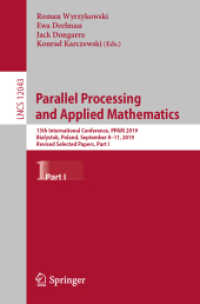- ホーム
- > 洋書
- > 英文書
- > Performing Arts
Full Description
New Theatre in Italy 1963-2013 makes the case for the centrality of late-millennium Italian avant-garde theatre in the development of the new forms of performance that have emerged in the 21st Century. Starting in the Sixties, young artists and militants in Italy reacted to the violence in their streets and ruptures in the family unit that are now recognized as having been harbingers of the end of the global post-war system. As traditional rituals of State and Church faltered, a new generation of cultural operators, largely untrained and driven away from political activism, formed collectives to explore new ways of speaking theatrically, new ways to create and experience performance, and new relationships between performer and spectator. Although the vast majority of the works created were transient, like all performance, their aesthetic and social effects continue to surface today across media on a global scale, affecting visual art, cinema, television and the behavioural aesthetics of social networks.
Contents
Preface. 1. The Sixties. Theate - literature - music: manifestoes, querelles, intermedia 1963-1967. 1.1. Fact and Atmosphere. 1.2. Literature calls for a theater of dissent and experimentation. 1.3. The querelle between literature and theatre: Gruppo '63. 1.4. The actor is the poet of oral language: Pasolini's Manifesto. 1.5. Theater at the center of society: The Ivrea Conference. 1.6. Intermedia and Musical Theater. 2. The Seventies (1968-1977): Setting Out. 2.1. Leaving Behind Theaters, Plays, Roles. 2.2. Theater to Change the World. 2.3. In Search of a Common Base: the Manifesto of arte povera. 2.4. The Van: Travel and Rest, Load and Unload. 2.5. A Collective Book, a Body of Joy. 2.6. Between 1968 and 1977: Action, Post-avant-garde, Third Theater. 2.7. Implosive/Expansive. 3. Between Death and Rebirth: the Eighties (1978-1988). 3.1. Unhappy Consciousness of the Late Seventies. 3.2. Neo-avant-garde/Post-avant-garde/Postmodern/Trans-avant-garde. 3.3. Postmodern: Metropolitan Landscape. 3.4. Reflecting on Theory: Anthropology and Postmodern = Intercultural. 3.5. Dawning: the Artwork Reborn. 4. Ideology: A Bad Habit to Leave Behind. The Nineties (1989-1999). 4.1. Revisionism and Conciliation. 4.2. Living in Transition. The Balance of "Pregress". 4.3. Being Posthumous. 4.4. Televised Pre-theater Telling True Stories. 4.5. Almost an epilogue. 5. Liveness - Play - Frontality: the 2000s. 5.1. Tragedy: End as Beginning. 5.2. Project: Producing Intermedia. 5.3. Dramaturgies of Diffuse Bodies. 5.4. Reality Trend and Pop. 5.5. Narrating by Elision and Detail. 5.6. Play - Event - Scene. 5.7. Confronting the Spectator. 6. Dramaturgies of Spectacle and Literary text. 6.1. Continuous and Discontinuous in New Theater. 6.1.1 Tradition in New Theater. 6.1.2. Cultures of Adoption and Orphancy. 6.1.3. The Workshop as Mode of Production. 6.1.4. Performance Text and Production Process. 6.2. The Theatrical Vocation of Pier Paolo Pasolini. 6.2.1. Experience. 6.2.2. Towards Effective Theater. 6.3. Testori: In the Belly of Theater. 6.3.1. The Word become Flesh. 6.3.2. Oedipus and Cleopatràs: Theatre's Latrine. 6.4. Franco Scaldati: An Enchanted Garden Where No One Dies. 6.4.1. Fluid Texts Without Genealogy: Eternal Becoming. 6.4.2. A Sensory Theater-World. 6.4.3. Shadow-Double Marionettes. 6.4.4. I Build Shadows. 7. Dramaturgy of Space. 7.1. Sensory-Motor Rupture. 7.2. Dynamic Simultaneous Space. 7.3. Audio-Chromatic Space. 7.4. Analytic Space. 7.5. Monitor Space. 7.6. Landscape and Errancy. 7.7. Constructing Space. 7.8. Installation and Digital Space. 8. Plural modes of the actor. 8.1. Actor and theme: critical and methodological issues. 8.2. Actor as collective body. 8.3. Without language or subject: from the monolog to the solo. 8.4. Blocking the body and freeing the voice. 8.6. Word as event. 8.7. Autofiction. 8.8. Over-representing representation. 8.9. Actor-machine-sculpture-animal-cyborg. 8.10. Spectral amplitude of the performer. 8.11. Audio body and actant.






